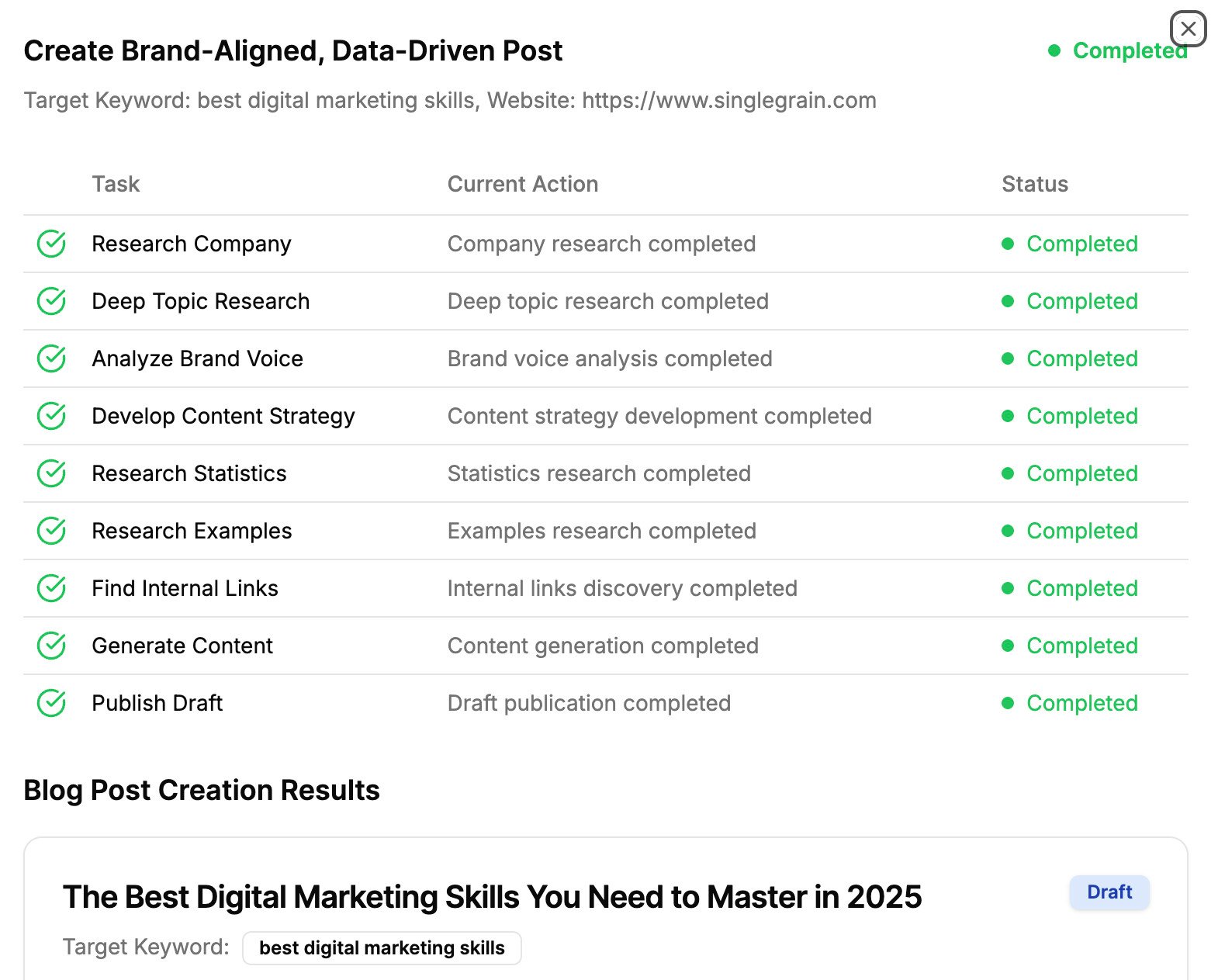Interested in sparking (or scaling) your account-based marketing strategy, but don’t know where to start? Then this is the article for you.
The sales process would be easier if you immediately connect with the leads with the highest value. Fortunately, this is possible with an account-based marketing strategy (ABM).
ABM is by no means a new approach to high ticket sales, but it’s made partly new again when enhanced by AI. When wielded well, it can be one of the most effective strategies for targeting qualified leads.
Even though this process usually leads toward higher marketing efficiency and revenue growth, not all marketers know how to do account-based marketing (the right way).
But that’s why we’re here. — to walk you through the steps to implement a successful account-based marketing framework.
Key Highlights on How To Do Account-Based Marketing
- The first step in account-based marketing is identifying the accounts likeliest to convert and creating an ideal customer profile (ICP) based on data you’ve collected on your target audience.
- Create an ABM team of marketing and sales professionals, plus other key stakeholders and reps, to ensure they’re on the same page.
- Conduct in-depth research on your accounts and understand the factors that make them want to convert.
- Create a robust marketing campaign that uses personalization and relevant content to target your accounts and keep them engaged in the sales funnel.
- Use the same channels that your accounts are using to enhance visibility.
- Monitor your ABM campaign using goals, metrics, and KPIs.
- After your accounts convert, continue to nurture your relationship with them for better retainment rates.
- For best results, start small with ABM, use tools and technology, focus on quality accounts, know when to make changes, and celebrate your wins.
TABLE OF CONTENTS:
Step 1: Identify Target Accounts
While ABM boasts a 208% increase in business revenue, you won’t see those results if you don’t know your target companies.
Start by creating a target account list. Discover who is visiting your website, following you on LinkedIn and other social media platforms, subscribing to your email newsletter, and is already buying your products and services. You can also view the data you collected on your CRM.
Once you have this data, create an ideal customer profile (ICP). Include business firmographics and the personal information of the role you’re targeting. Your ICP should be a snapshot of the executive or manager you will contact and the business they work for (such as company type, industry, annual revenue, and location). You’ll use this ICP for all account targeting tactics.
Step 2: Build a Cross-Functional ABM Team
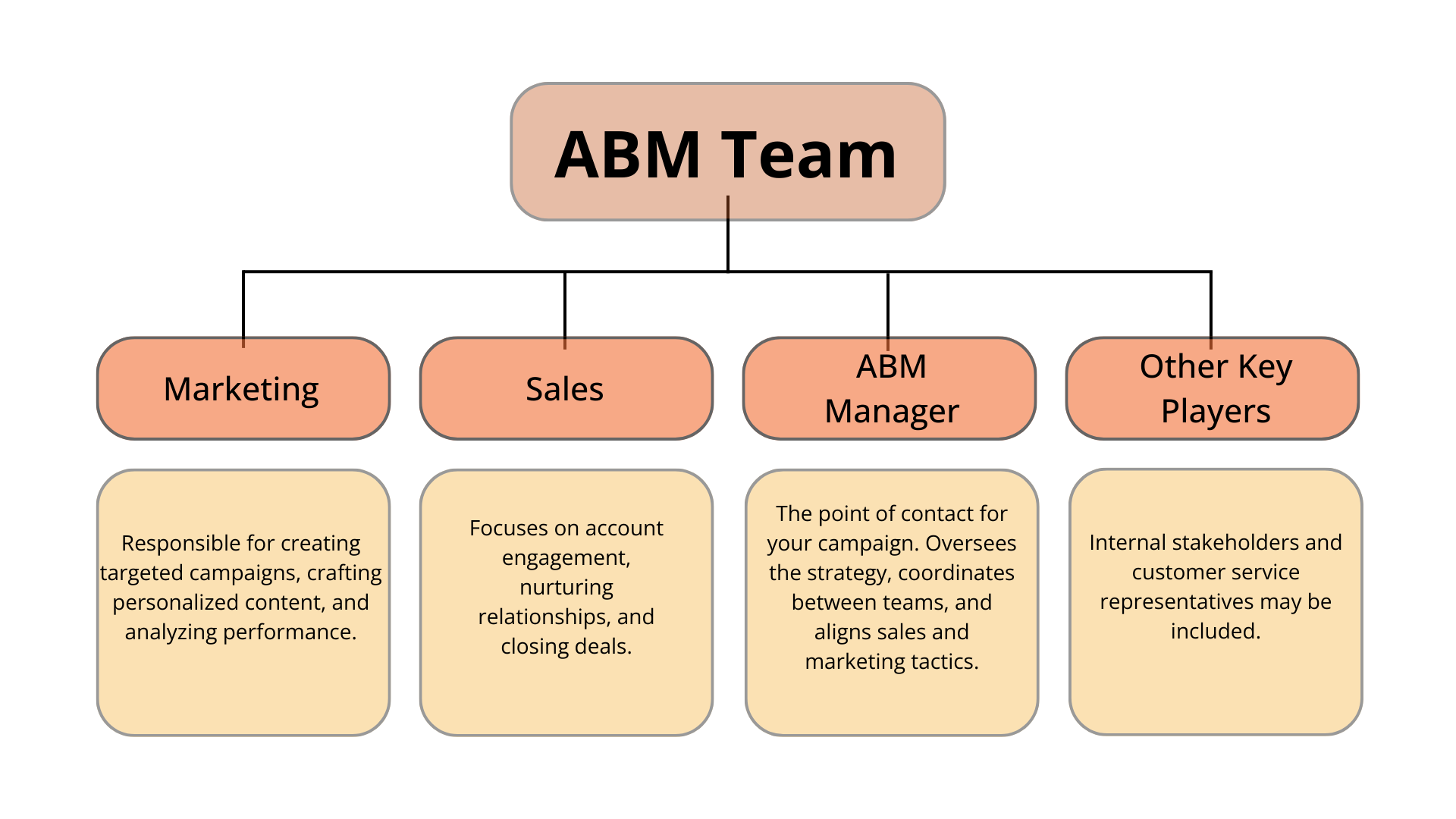
ABM requires close collaboration between various teams, specifically marketing and sales reps. Create a cross-functional team where these teams can collaborate on a single strategy. ABM strives for consistent customer experiences, so everyone should work toward the same marketing and sales efforts.
Here’s a snapshot of what an ABM team will look like:
- Marketing: Responsible for creating targeted campaigns, crafting personalized content, and analyzing performance.
- Sales: Focuses on account engagement, nurturing relationships, and closing deals.
- ABM manager: The point of contact for your campaign. Oversees the strategy, coordinates between teams, and aligns sales and marketing tactics.
- Other key players: Internal stakeholders and customer service representatives may be included.
In addition to planning the strategy, your ABM team should identify tools and resources, set a budget, and establish goals. Always ensure these team members have excellent communication.
Step 3: Develop Deep Account Insights
Understanding your target accounts and what makes them convert is critical for effective ABM. Conduct in-depth research to uncover key details about each account. This may include:
- Industry trends.
- Pain points, challenges, and goals.
- Preferred communication channels.
Step 4: Create Marketing and Content Campaigns
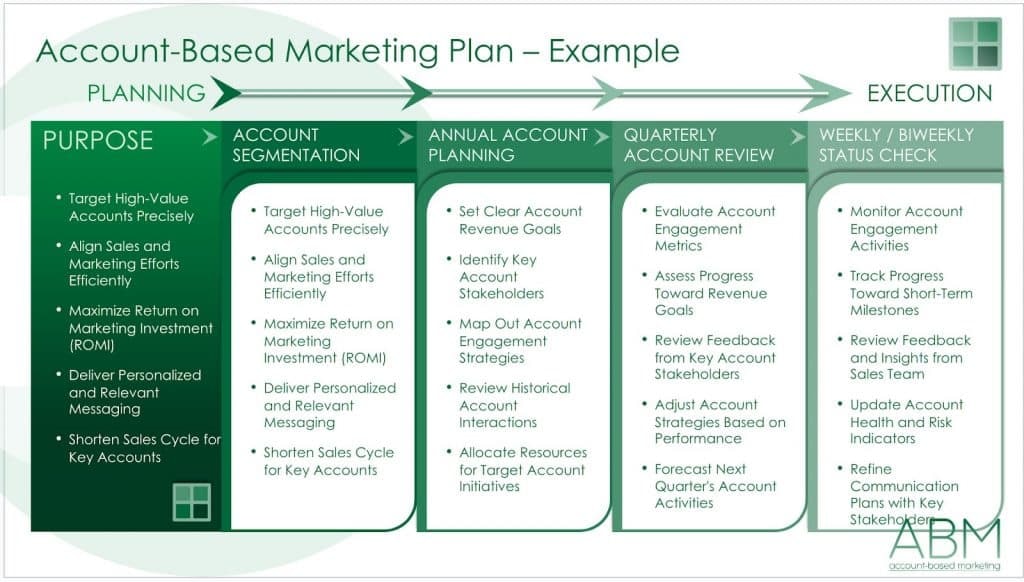
Source: Linked Helper
Targeting high-value accounts is the first step in the ABM sales funnel. That’s why you need to start strong with a powerful marketing campaign.
Personalization is at the heart of ABM. Instead of using general marketing and advertising tactics, personalization will prove that you understand the needs of specific companies, and it will be easier to sell your products and services as their solution.
Develop tailored content and campaigns that resonate with each account. Examples include:
- Case studies: Showcase how your solution addresses similar challenges.
- Personalized emails: Craft messages that speak directly to the account’s pain points.
- Account-based advertising: Use account-specific ads to reinforce your messaging.
- Hint: One of best tools to build account-based marketing ads at scale is by using Karrot.ai. It’s great for transforming the effort involved with creating a single ad and applying it to every target account on your brand’s radar.
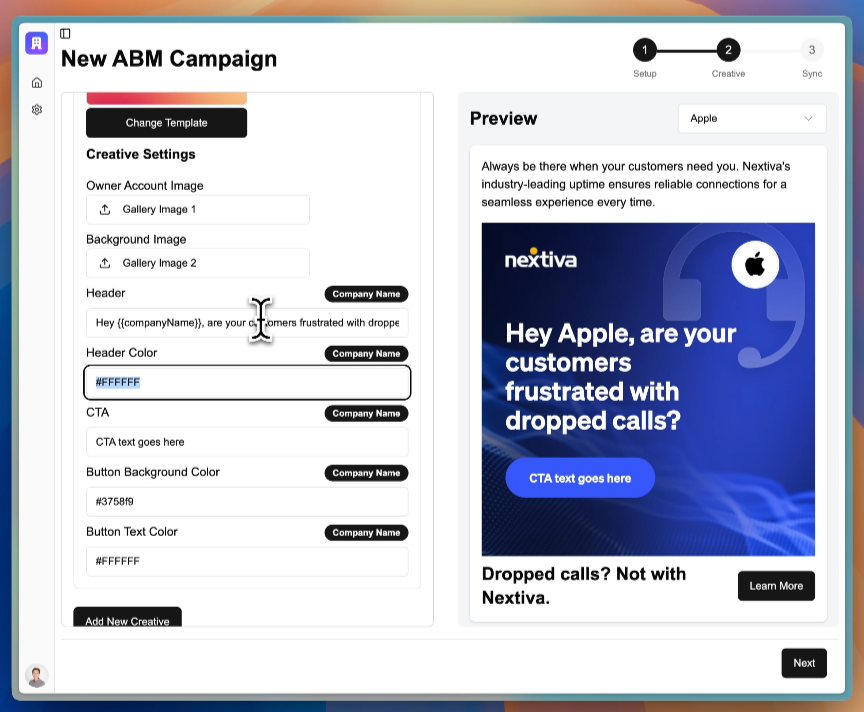
- Hint: One of best tools to build account-based marketing ads at scale is by using Karrot.ai. It’s great for transforming the effort involved with creating a single ad and applying it to every target account on your brand’s radar.
- Interactive content: Create webinars, whitepapers, or videos that address the account’s unique needs.
- Blogs: Write about topics in the account’s niche and mention pain points and other challenges.
Step 5: Choose the Right ABM Channels
ABM campaigns are most effective when delivered through the channels that your accounts are using. Find the channels your accounts use to discover the latest industry trends and find solutions to their problems. Here are popular examples:
- Email marketing
- Social Media (specifically LinkedIn)
- Events
- Direct Mail
- Advertising
Step 6: Monitor Your Campaign
While no ABM campaign comes with one-size-fits-all goals, the metrics you measure will likely differ from traditional lead generation or marketing strategies. That’s because you’ll want your accounts to go down the ABM pipeline and ensure you generate revenue from these leads.
Some key metrics you’ll want to track include:
- Account value.
- Engagement rates (email opens, clicks, and ad impressions).
- Website activity from target accounts.
- Opportunities created.
- Closed-won deals.
- Pipeline contribution and revenue impact.
- Customer lifetime value.
Adjust your campaigns based on real-time data to optimize results.
Step 7: Nurture Relationships
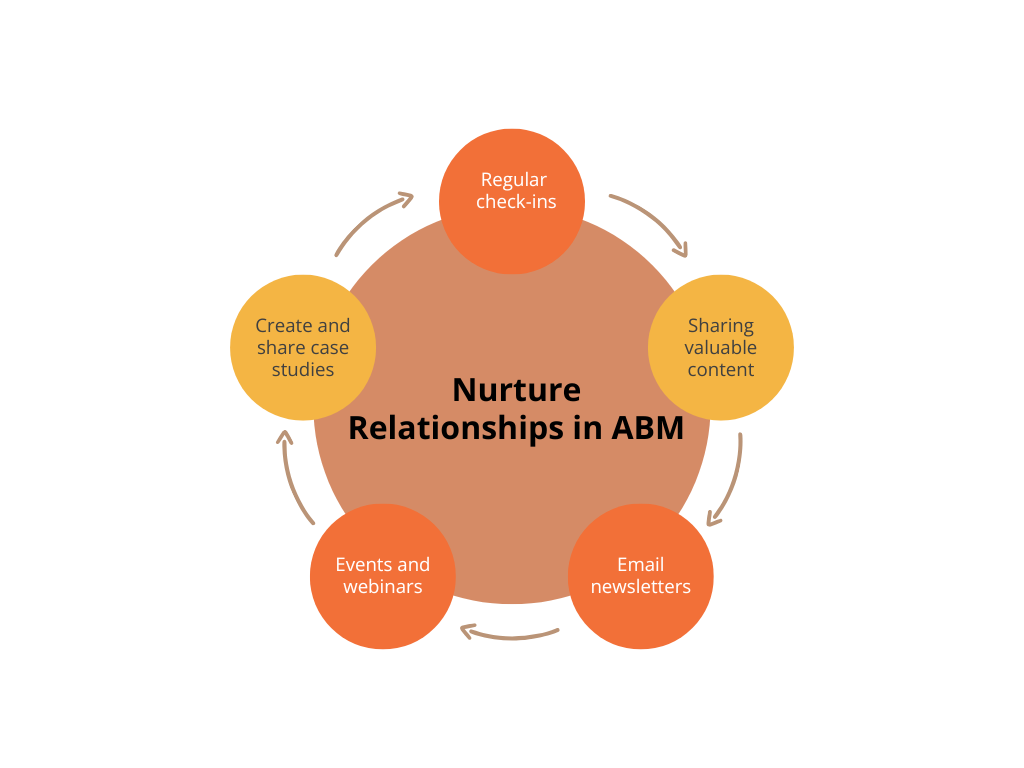
ABM is not a one-time effort. Forging strong relationships with valuable customers is key after they convert. Continuously nurture relationships with decision-makers and influencers within your target accounts over an extended period with personalized customer experiences. Strategies include:
- Regular check-ins, meetings, and personalized follow-ups.
- Sharing valuable content and industry reports.
- Offering a free subscription to your email newsletter.
- Inviting them to exclusive events or webinars.
- Create and share case studies about how your product or service benefitted the account.
Understand that these relationships aren’t short-lived. You’ll want to hold these account relationships for months or years after they first convert. This is especially true if you have a SaaS-based business or any company with a subscription-based model. If there’s a problem they’re facing, you want your business to be their first line of contact.
Best Practices for ABM Success
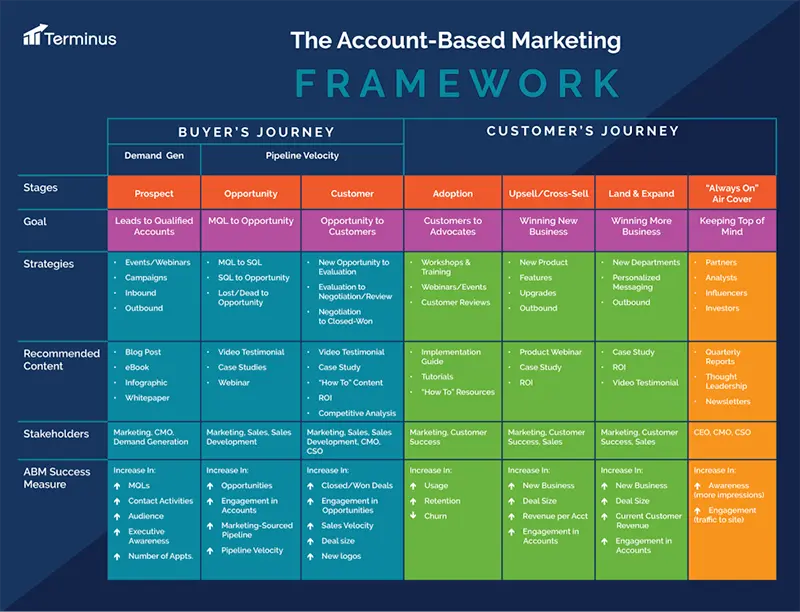
Source: Newoldstamp
Following these steps may not be enough to generate sales from ABM. Here are a few tactics and best practices to ensure you’re building revenue.
Start Small
Don’t jump into ABM. Start small by defining clear goals and creating ICPs. Begin with a pilot program targeting a few key accounts and scale up when you’re ready. Always offer a feedback loop to your team to work out internal problems. It’s best to jump through hoops early in your campaign and learn from these mistakes.
Use Account-Based Marketing Tools
ABM tools will streamline your account-based marketing strategy and make it easier for your accounts to move through the sales cycle.
Some examples of tools to use include:
- ABM platforms (such as Demandbase and 6sense).
- Data collection, forms, surveys, and forms (such as Jotform).
- Lead capture tools (such as Flowlu).
- CRMs (such as HubSpot and Salesforce).
- Company intelligence software (such as Zoominfo).
- Sales strategy tools (such as LinkedIn Sales Navigator).
- Sales pipeline software (such as Terminus).
- Marketing automation platform (such as ActiveCampaign and Marketo)
Focus on Quality Accounts

You won’t get results from your ABM campaign if you don’t prioritize account selection and accurate customer profiling. Only target the highest quality accounts that are likelier to convert. After these accounts buy into your products or services, prioritize meaningful interactions with these customers over sheer sales volume.
Stay Agile
Industry trends and other unpredictable events can disrupt your ABM campaign. Be prepared to adapt your strategy based on account feedback and market changes. Even if the market is stable, review your objectives and update your strategy when needed.
How to Do Account-Based Marketing: Do You Still Need Help?
An account-based marketing strategy is effective because you connect with high-quality accounts during the initial marketing and sales stages, driving more growth than traditional marketing strategies. If you don’t know how to do account-based marketing, identify these high-value target accounts and craft a marketing campaign and personalized campaigns to engage them down the sales funnel.
Don’t forget to align your sales and marketing teams to craft your account-based marketing campaigns, invest in the right tools, agree on a budget, and set goals. This way, you can close deals, build strong relationships with your accounts, and improve your ROI.
Have you tried ABM and couldn’t convert accounts or achieve measurable results? You shouldn’t give up on ABM. An ABM marketing firm can target your ideal accounts and drive them down the sales funnel.
If you’re ready to level up your account-based marketing strategy, Single Grain’s ABM experts can help!👇
Related Video
For more insights and lessons about marketing, check out our Marketing School podcast on YouTube.
Frequently Asked Questions on How to do Account Based Marketing
-
How do I identify the right accounts for ABM?
Start by analyzing your ideal customer profile (ICP). Use data such as company size, revenue, industry, location, and past success stories to pinpoint high-value accounts. Collaborate with sales teams to prioritize accounts with the highest potential for long-term growth.
-
What tools and technologies are essential for ABM?
ABM requires tools for customer relationship management (CRM), marketing automation, and data analytics. Platforms like HubSpot, Karrot, Salesforce, and LinkedIn can help with targeting, while tools like Demandbase and 6sense provide insights for personalization at scale.
-
How do I create personalized campaigns for target accounts?
How do I create personalized campaigns for target accounts?
-
How should sales and marketing teams collaborate in ABM?
Align sales and marketing efforts by setting shared goals, defining account-specific strategies, and maintaining consistent communication. Regular meetings and shared KPIs ensure both teams stay aligned throughout the process.
-
How do I measure the success of ABM campaigns?
Track metrics such as account engagement, pipeline velocity, deal size, and conversion rates. Use account-level analytics to determine how well your campaigns resonate with specific accounts and adjust your strategy as needed.
-
What are some common challenges when starting ABM?
Challenges include misalignment between sales and marketing, lack of account data for personalization, and difficulty scaling campaigns. To overcome these, invest in the right tools, foster collaboration, and start with a pilot program before expanding.
-
What’s the best way to scale ABM efforts?
Start small with strategic ABM for a handful of accounts, then expand into ABM Lite or Programmatic ABM as you refine your processes. Use automation and data-driven tools to personalize at scale without losing the quality of engagement.






